BELLEISLE MARSH
Spring: *** Summer: **** Fall: *** Winter: *
Directions to this Site: If you are coming from the east (say Halifax), take exit 20 from Highway 101 and turn right or WSW onto Highway 1. Proceed 14.2 km through Bridgetown to Belleisle and the road on the left into the Belleisle Marsh. You will see the sign a few hundred metres along this dirt road.
If you are coming from the west (say Yarmouth), take exit 22 from Highway 101. When you reach Highway 8, turn left or to the NNW toward Annapolis Royal. Proceed 6.9 km north, then northwest, to the junction of Highway 1 and Highway 8 (St. George Street in town) in Annapolis Royal. Turn right or ENE on Highway 1 or Prince Albert Road and go 13.2 km to the road on the right into the Belleisle Marsh. You will see the sign a few hundred metres along this dirt road.
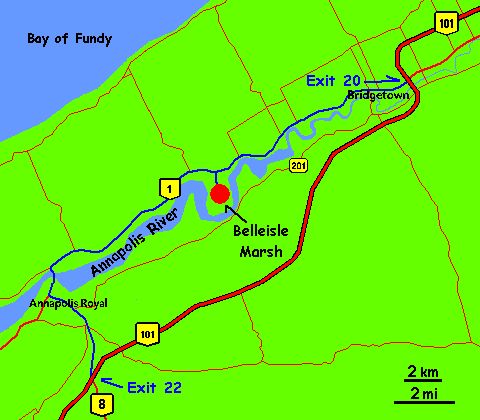 Location Map of the Belleisle Marsh area
Location Map of the Belleisle Marsh area
Site Description and Birding Information: This lovely bit of Acadian dykeland was entirely hay fields in years past and was an important refuge for grassland birds, such as Gray Partridge, Eastern Meadowlark and even Loggerhead Shrike, which have now disappeared. It still harbours some grassland birds such as Bobolink, Eastern Kingbird and Savannah Sparrow. There is a parking area about 500 metres from Highway 1. It is well marked and is shown on the map below by a green P. You can park here for a quiet walk or you can drive the roads, which may or may not be passable, depending on your tolerance of roughness and mud. Best to wallk.
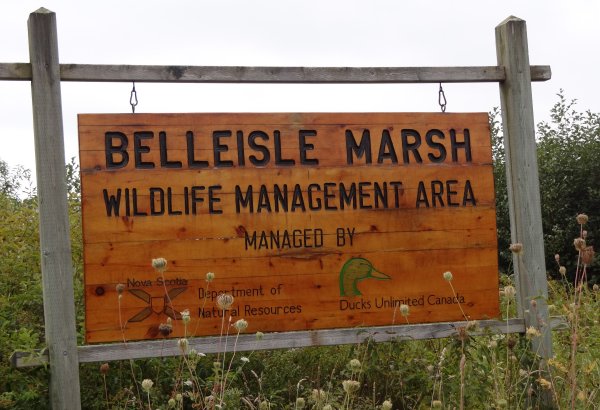 Belleisle Marsh Entrance Sign - Larry Neily
Belleisle Marsh Entrance Sign - Larry Neily
It is now the home of several Ducks Unlimited empoundments, and so attracts waterfowl and marsh birds in season. There are four ponds, circled in green and numbered on the map below (roads and trails are in red and sometimes-used gates in yellow). In 2022, ponds 1, 2 and 3 were mostly overgrown with cattails, but each had some open water. Pond 4 was mostly water with a few small islets. The latter is where most of the waterfowl hang out. Sora can be hear calling from all 4 ponds. Virginia Rail is sometimes heard, especially from Pond 3. The best way to bird Belleisle Marsh is surely on foot, aside from the fact that the roads are very poor and not suitable for most cars and that the main loop road is often gated in summer. You can walk the largely overgrown "road" to Pond 1. It is just over 8 tenths of a kilometre from the parking lot. You can walk around the pond, it is about 1.3 kms. It is wettest on the west side and fairly dry on the river side. Most interesting by far is the main loop road, starting 400 m south of the parking area. The entire loop, which goes around the north, west and south of Pond 4 and then along the west side of Pond 3 (allowing access to Pond 2 from the north end of Pond 3) is about 3.7 km. This loop provides viewing of most of the best birding areas here. Warning: This area, especially any long grass you may walk through has many ticks. Be sure to check for them thoroughly!
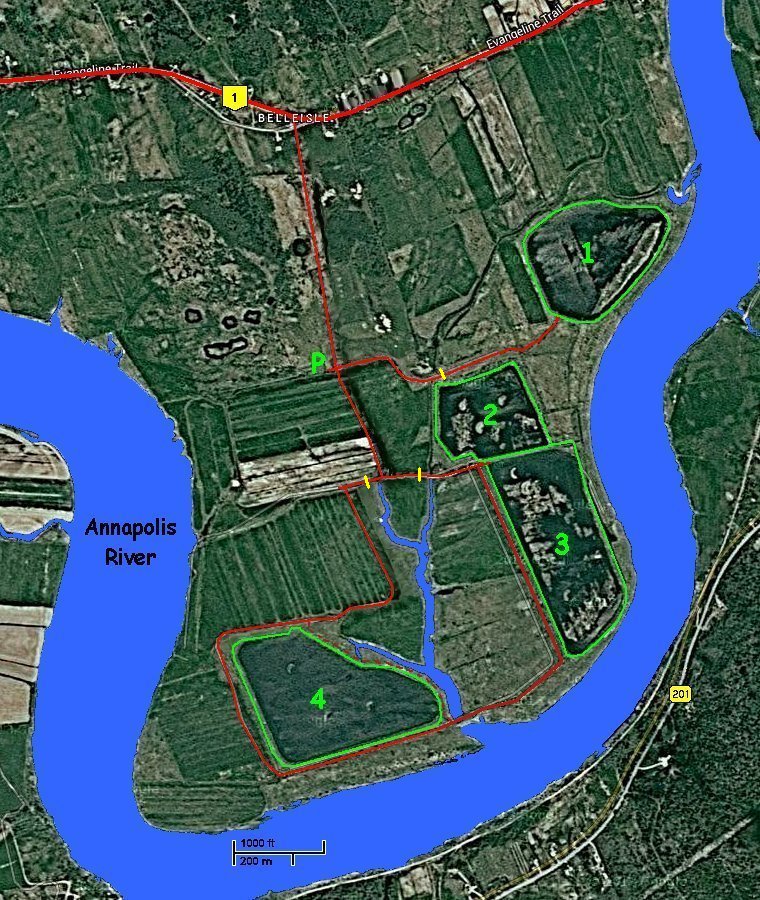 Belleisle Marsh Map - for another view move your cursor over the map
Belleisle Marsh Map - for another view move your cursor over the map
A good variety of birds may be seen with presistance from spring through freeze-up. The entry road immediately passes Little Brook Lane, which has feeders that are worth checking. When you pass the sign for the marsh, you have second growth woodland and scrubland on both sides of the road. This is a good spot for nocturnal birds in summer. At and soon after dusk, American Woodcocks come zipping up the lane and Common Nighthawks can be seen close overhead as they arrive at the marsh to feed. A Northern Saw-whet Owl was heard here several times in June 2020. When you leave the woods, you pass a marshy area before arriving at the parking lot. Watch along here and in any of the many ditches on the greater marsh for Swamp Sparrows.
From the parking area, it is best to go on foot, though the entire loop described above can usually be driven when the gates are open. Never try driving it when conditions are or have recently been wet. As I said, best to walk. From the parking area you can walk to pond 1, which can be good for rails and nighthawks, but not so much for ducks, since open water is rare. The best bet for the widest variety of birds is the large loop described above. From the parking area, it is 400 m to the loop and 3.7 km around it, making a total of 4.5 km back to the parking area. You can shorten the hike by 0.8 km and add to the tick count by taking the skecthy trail along the pond 4 NE edge. Watch for American Pipits and Horned Larks (fall & early winter) in the fields on either side as you proceed SSE to the T-junction. The fields to the south of the T-junction are the best spots for Bobolinks in spring and summer. Flocks of Canada Geese use these fields in early spring to graze. In late April 2020 they were joined by a Greater White-fronted Goose, which stayed for a week or so.
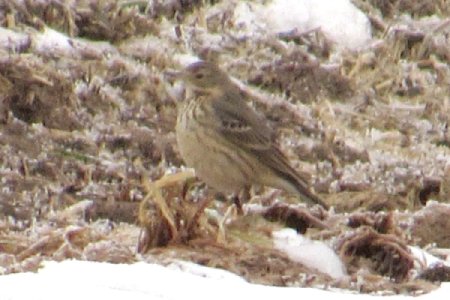 American Pipit at Belleisle Marsh on Jan. 16, 2021 - Larry Neily
American Pipit at Belleisle Marsh on Jan. 16, 2021 - Larry Neily
|
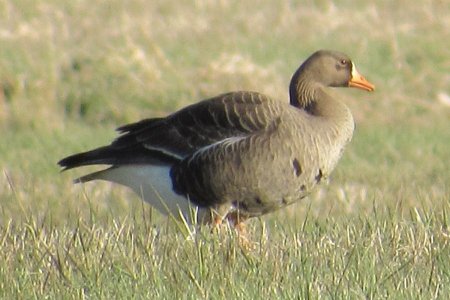 Greater White-fronted Goose at Belleisle Marsh on Apr. 25, 2020 - Larry Neily
Greater White-fronted Goose at Belleisle Marsh on Apr. 25, 2020 - Larry Neily
|
My preference is to go around the loop counter-clockwise, but it is basically a coin toss. I'll give a quick set of distance and direction going counter-clockwise. At the T-junction turn right or west, cross the creek, pass the gate, and at the 110 metre mark, take a left to follow the "main" road. Go SSE 415 m and turn right or WSW. At 345 m along this 675 m stretch along the north side of pond 4 is the path up to the trail that follows the brem ESE along the NE edge of pond 4. Continuing along the "main" road all 675 m to the NW corner of pond 4, turn left or SSE and go another 400 m to the SW corner of pond 4. There, take another left to the ENE and go 600 m to the SE corner of pond 4, where you would come out if you sloughed through the shortcut. You now cross the stream outlet and going 500 m NE beyond the trail junction, you will reach the SW corner of pond 3. Turn left or NNW and go 700 m to the NW corner of pond 3 (which is also the SW corner of pond 2). Here you can make a brief aside to the right or east to walk up onto the dyke between ponds 2 & 3 to view both of them. Back to the loop, after having walked along the west sidem of pond 3 turn left or east and walk 300 m and you have finished the loop and have only the 400 m NNW section to get back to the parking area.
Watch for Northern Harriers, Turkey Vulture, Bald Eagles and Ospreys (the latter have a nest on a platform near the stream outlet on the south leg of the loop). Savannah Sparrrows and a few Bobolinks may greeting you along the road. Because the ducks can always see you, they will always be on the far side of the pond from you, so a spotting scope is a valuable item. Pond 4 is the best empoundment for waterfowl currently. Spring breakup on the pond brings Wood Duck, Blue-winged Teal, Northern Pintail, Northern Shoveler, Gadwall, Mallard, American Black Duck, Green-winged Teal, Ring-necked Duck, as well as Pied-billed Grebe, Sora, Wilson's Snipe & American Bittern; and 4 species of swallows hawking over the pond. Lots of them stay to breed. Watch any islands on the ponds as this is where early shorebirds are likely to be seen roosting. As you crossthe road over the stream outlet, watch for Double-crested Cormorant and check the Osprey nest for occupants.
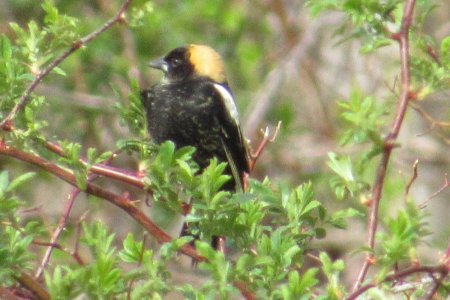 A male Bobolink at Belleisle Marsh on May 11, 2021 - Larry Neily
A male Bobolink at Belleisle Marsh on May 11, 2021 - Larry Neily
|
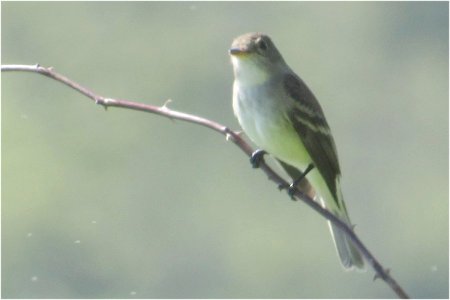 Willow Flycatcher at Belleisle Marsh on May 25, 2022 - Larry Neily
Willow Flycatcher at Belleisle Marsh on May 25, 2022 - Larry Neily
|
From the stream outflow to pond 3 and along pond 3 there are woods and scrubby fields. Listen for Nelson's Sparrow along the river edge. Salt water goes upriver well past here. Especially along the segment going along pond 3, the woods on the west side of the road can be good for warblers in spring. Probably, Virgina Rails are annual here, but they are not as vocal as the many Sora in the area. One has favoured pond 3 in recent years. It is also home to one of Nova Scotia's few pairs of Willow Flycatchers (along the west edge of Pond 3, just south of Pond 2). Beware the nearly identical Alder Flycatchers that are present on the brushy parts of the marsh. Listen careful to the calls to separate them (Alder - "fee-be'-ou" and Willow - "fitz'-bew"). This "corner" has been good for less common or rare birds over the years, such as a Warbling Vireo singing for a mate on June 1, 2018; or a young Northern Shrike that successfully overwintered there in 2019-2020.
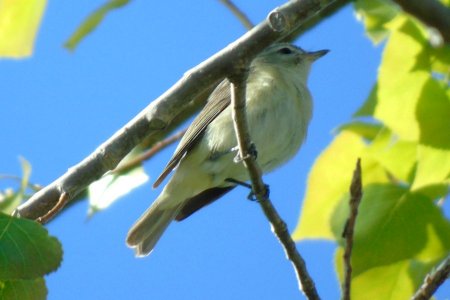 Warbling Vireo at Belleisle Marsh on Jun. 1, 2018 - Larry Neily
Warbling Vireo at Belleisle Marsh on Jun. 1, 2018 - Larry Neily
|
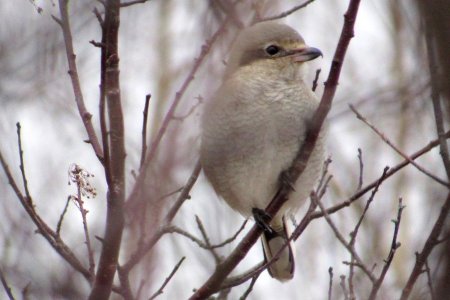 Northern Shrike at Belleisle Marsh on Jan. 11, 2020 - Larry Neily
Northern Shrike at Belleisle Marsh on Jan. 11, 2020 - Larry Neily
|
Return to Birding Annapolis County's Annapolis County Birding Site Map.
Return to NeilyWorld NeilyWorld.
|








